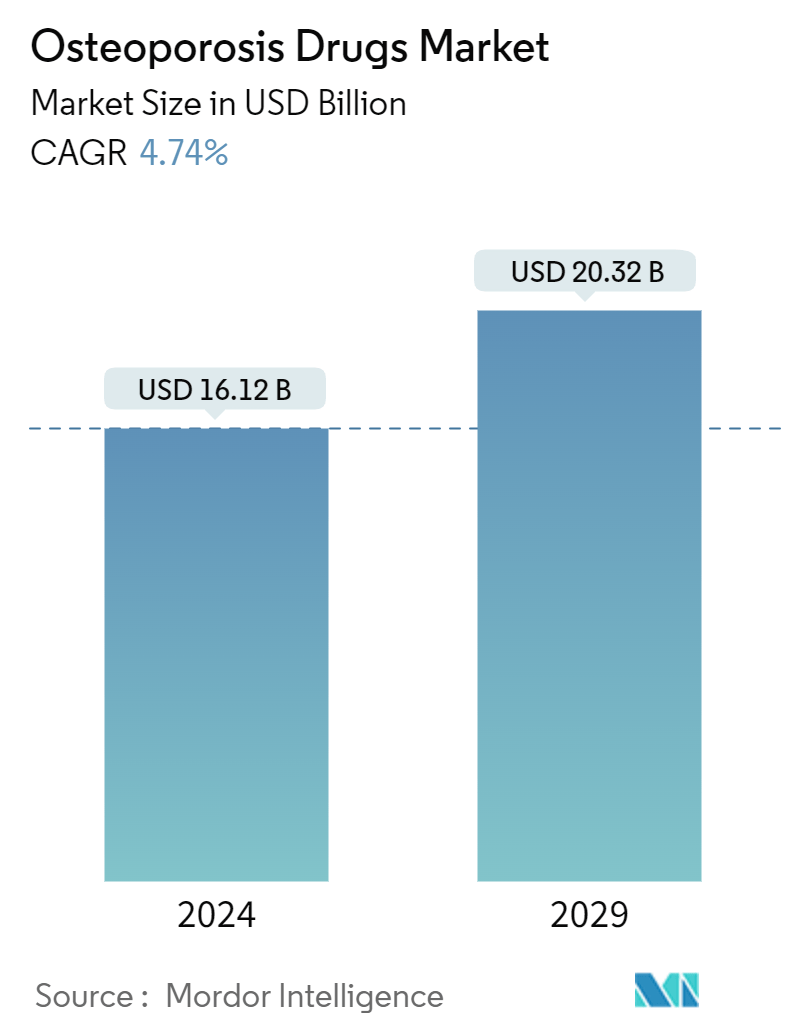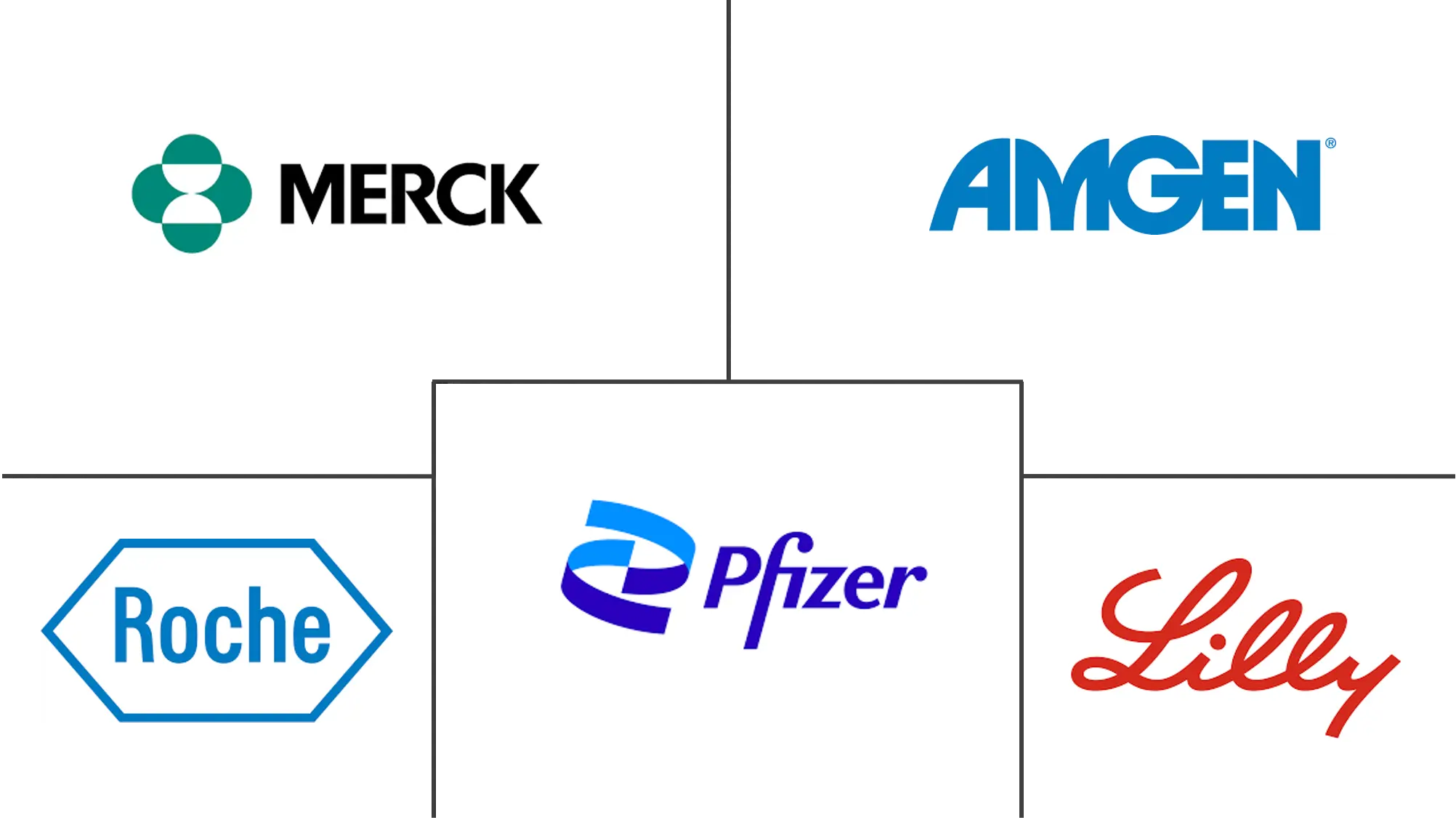Market Size of Osteoporosis Drugs Industry

| Study Period | 2019 - 2029 |
| Market Size (2024) | USD 16.12 Billion |
| Market Size (2029) | USD 20.32 Billion |
| CAGR (2024 - 2029) | 4.74 % |
| Fastest Growing Market | Asia Pacific |
| Largest Market | North America |
| Market Concentration | Medium |
Major Players
*Disclaimer: Major Players sorted in no particular order |
Osteoporosis Drugs Market Analysis
The Osteoporosis Drugs Market size is estimated at USD 16.12 billion in 2024, and is expected to reach USD 20.32 billion by 2029, at a CAGR of 4.74% during the forecast period (2024-2029).
The rising prevalence of osteoporosis, along with the growing geriatric population and fragility fractures, is expected to drive demand for effective treatment solutions. These demographic and health trends are anticipated to significantly contribute to the expansion of the osteoporosis drugs market. For instance, according to a report published in the Archives of Osteoporosis Journal in April 2024, the prevalence of osteoporosis is rising, showing a prevalence of 15.9% in individuals aged 50 and over, with a significant gender disparity. Many osteoporosis-related fractures remain undiagnosed, and only 30% of diagnosed individuals receive proper treatment, especially with a pronounced treatment gap in men. This increasing need for diagnosis and treatment directly fuels demand for osteoporosis drugs, driving market growth.
Furthermore, spinal cord injuries are associated with the development of osteoporosis. For instance, according to a report published in the BMC Medicine Journal in July 2024, the rising incidence of spinal cord injuries, with an overall incidence rate of 23.77 per million people, leads to increased mobility challenges and a higher risk of bone-related complications. As individuals with spinal cord injuries are prone to developing osteoporosis due to prolonged immobility, the need for effective therapeutic interventions is becoming more urgent. This growing demand for osteoporosis management solutions is propelling the expansion of the osteoporosis drugs market.
Additionally, the rising launches and approvals by the market players are expected to boost the market growth during the forecast period. For instance, in November 2023, Teva Pharmaceuticals Inc., a U.S. affiliate of Teva Pharmaceutical Industries Ltd., received approval for a generic version of Forteo in the U.S. market. The teriparatide injection is indicated for the treatment of osteoporosis in select women and men. Similarly, in August 2022, the Ministry of Health, Labour, and Welfare (MHLW) approved the Edirol Tablet by Towa Pharmaceutical in Japan. Introducing new generic formulations and approvals of osteoporosis treatments enhances market accessibility and provides more therapeutic options, driving the growth of the osteoporosis drugs market by addressing unmet clinical needs.
In conclusion, the growth of the osteoporosis drugs market is driven by increasing incidences of osteoporosis, rising demand for effective treatments due to related fractures and injuries, and the introduction of new therapeutic formulations and approvals.
However, stringent approval and marketing regulations are expected to restrain the market growth.
Osteoporosis Drugs Industry Segmentation
As per the report's scope, osteoporosis drugs are pharmacological agents designed to prevent bone loss, enhance bone density, and reduce the risk of fractures in individuals with weakened skeletal structures due to reduced bone mass. These drugs typically work by either inhibiting bone resorption or stimulating bone formation, offering therapeutic solutions to manage and treat osteoporosis. The osteoporosis drugs market is segmented by drug type, application, and geography. The drug type is further divided into parathyroid hormone therapy, bisphosphonates, calcitonin, RANKL Inhibitors, and other drug types. The application segment is further segmented into primary osteoporosis and secondary osteoporosis. The geography segment is further divided into North America, Europe, Asia-Pacific, Middle East and Africa, and South America. The market report also covers the estimated market sizes and trends for 17 countries across major regions globally. The report offers the market size and forecast in value (USD) for the above segments.
| By Drug Type | |
| Parathyroid Hormone Therapy | |
| Bisphosphonates | |
| Calcitonin | |
| RANKL Inhibitors | |
| Other Drug Types |
| By Application | |
| Primary Osteoporosis | |
| Secondary Osteoporosis |
| Route of Administration | |
| Oral | |
| Injectable | |
| Others |
| Geography | ||||||||
| ||||||||
| ||||||||
| ||||||||
| ||||||||
|
Osteoporosis Drugs Market Size Summary
The osteoporosis drugs market is poised for steady growth, driven by an increasing prevalence of osteoporosis and the rising incidence of bone-related issues among younger populations. The market is experiencing a boost from the potential use of osteoporosis treatments in managing COVID-19, as studies suggest these drugs may reduce infection rates. The development and approval of new therapies, such as raloxifene, and the ongoing research into the efficacy of Rank ligand inhibitors are further propelling market expansion. These inhibitors, known for their positive impact on bone metabolism and mineral density, are gaining traction due to their potential synergistic effects when combined with other treatments. However, the market's growth is tempered by stringent regulatory challenges.
North America is expected to maintain its dominance in the osteoporosis drugs market, supported by a robust healthcare infrastructure, a high prevalence of osteoporosis, and the presence of key industry players. The United States, in particular, holds a significant market share, attributed to its large adult population and collaborative efforts to enhance medical standards. The COVID-19 pandemic has disrupted treatment protocols, prompting organizations like the American Society for Bone and Mineral Research to issue guidelines to ensure continuity of care. The competitive landscape is marked by the presence of major companies such as Pfizer, Eli Lilly, and Merck, which are engaging in strategic collaborations, high R&D investments, and product innovations to sustain their market positions.
Osteoporosis Drugs Market Size - Table of Contents
-
1. MARKET DYNAMICS
-
1.1 Market Overview
-
1.2 Market Drivers
-
1.2.1 Increase in Incidence of Osteoporosis
-
1.2.2 Rise in the Geriatric Population
-
-
1.3 Market Restraints
-
1.3.1 Stringent Approval and Marketing Regulations
-
-
1.4 Porter's Five Forces Analysis
-
1.4.1 Threat of New Entrants
-
1.4.2 Bargaining Power of Buyers/Consumers
-
1.4.3 Bargaining Power of Suppliers
-
1.4.4 Threat of Substitute Products
-
1.4.5 Intensity of Competitive Rivalry
-
-
-
2. MARKET SEGMENTATION (Market Size by Value - in USD)
-
2.1 By Drug Type
-
2.1.1 Parathyroid Hormone Therapy
-
2.1.2 Bisphosphonates
-
2.1.3 Calcitonin
-
2.1.4 RANKL Inhibitors
-
2.1.5 Other Drug Types
-
-
2.2 By Application
-
2.2.1 Primary Osteoporosis
-
2.2.2 Secondary Osteoporosis
-
-
2.3 Route of Administration
-
2.3.1 Oral
-
2.3.2 Injectable
-
2.3.3 Others
-
-
2.4 Geography
-
2.4.1 North America
-
2.4.1.1 United States
-
2.4.1.2 Canada
-
2.4.1.3 Mexico
-
-
2.4.2 Europe
-
2.4.2.1 Germany
-
2.4.2.2 United Kingdom
-
2.4.2.3 France
-
2.4.2.4 Italy
-
2.4.2.5 Spain
-
2.4.2.6 Rest of Europe
-
-
2.4.3 Asia-Pacific
-
2.4.3.1 China
-
2.4.3.2 Japan
-
2.4.3.3 India
-
2.4.3.4 Australia
-
2.4.3.5 South Korea
-
2.4.3.6 Rest of Asia-Pacific
-
-
2.4.4 Middle East and Africa
-
2.4.4.1 GCC
-
2.4.4.2 South Africa
-
2.4.4.3 Rest of Middle East and Africa
-
-
2.4.5 South America
-
2.4.5.1 Brazil
-
2.4.5.2 Argentina
-
2.4.5.3 Rest of South America
-
-
-
Osteoporosis Drugs Market Size FAQs
How big is the Osteoporosis Drugs Market?
The Osteoporosis Drugs Market size is expected to reach USD 16.12 billion in 2024 and grow at a CAGR of 4.74% to reach USD 20.32 billion by 2029.
What is the current Osteoporosis Drugs Market size?
In 2024, the Osteoporosis Drugs Market size is expected to reach USD 16.12 billion.

